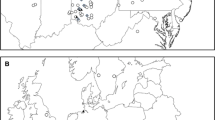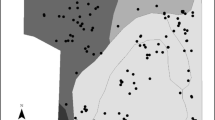Abstract
Frequency-dependent disease impacts may contribute to the maintenance of genetic diversity and sexual reproduction in plant populations. In earlier work with experimental wheat (Triticum aestivum) populations at a single density, we found that stripe rust (caused by Puccinia striiformis) created frequency-dependent selection on its host but competitive interactions between host genotypes reduced the potential for disease to maintain genetic polymorphisms in this highly self-pollinated species; the weaker competitor actually exhibited positive disease-mediated frequency-dependent selection. Based on these results we predicted that at low density, where the overall level of competition is lower, disease would have a stronger impact relative to competition and thus be more likely to maintain genetic polymorphisms; at low densities the greatest effect of disease for negative frequency-dependent selection should be seen in the weak competitor. Here we report on results with wheat stripe rust in which we altered both the frequency and density of host genotypes in factorial combinations of two-way mixtures where each host genotype was attacked by its own specialized race of rust. Within each density disease levels increased with genotype frequencies, creating frequency-dependent disease attack at all densities. Similarly, disease created negative frequency-dependent selection on its host at all densities, as a genotype’s fitness was often greater at low than high frequency when disease was present. Disease levels increased with plant density in 1997 but decreased in 1998. While increasing plant density reduced absolute fitness, presumably as a result of increased competition, a genetic polymorphism was not more likely to be maintained at low than high density as we had predicted. Within each density, the impact of disease was insufficient to reverse the slope of the relationship between absolute fitness and planted frequency from positive to negative for the less competitive host genotype, thus preventing the maintenance of a genetic polymorphism.







Similar content being viewed by others
References
Allard RW, Adams J (1969) Population studies in predominantly self-pollinating species. XIII. Intergenotypic competition and population structure in barley and wheat. Am Nat 103:621–645
Akanda SI, Mundt CC (1996) Effects of two-component wheat cultivar mixtures on stripe rust severity. Phytopathology 86:347–353
Alexander HM, JJ Burdon (1984) The effect of disease induced by Albugo candida (white rust) and Peronospora parsitica (Downy mildew) on the survival and reproduction of Capsella bursa-pastoris (shepherd’s purse). Oecologia 64:314–318
Alexander HM, Roelfs AP, Cobbs G (1986) Effects of disease and plant competition on yield in monocultures and mixtures of two wheat cultivars. Plant Pathol 35:457–465
Alexander HM (1991) Plant population heterogeneity and pathogen and herbivore levels: a field experiment. Oecologia 86:125–131
Alexander HM (1992) Evolution of disease resistance in natural plant populations. In: Fritz RS, Simms EL (eds) Plant resistance to herbivores and pathogens. The University of Chicago Press, Chicago, pp 326–344
Alexander HM, Antonovics J, Kelly AW (1993) Genotypic variation in plant disease resistance: physiological resistance in relation to field disease transmission. J Ecol 81:325–333
Antonovics J, Ellstrand NC (1984) Experimental studies of the evolutionary significance of sexual reproduction. I. A test of the frequency-dependent selection hypothesis. Evolution 38: 103–115
Antonovics J, Kareiva P (1988) Frequency-dependent selection and competition: empirical approaches. Phil Trans R Soc Lond B 319: 601–613
Augspurger CK, Kelly CK (1984) Pathogen mortality of tropical tree seedlings. Experimental studies of the effects of dispersal distance, seedling density, and light conditions. Oecologia 61: 211–217
Bergelson J (1990) Life after death: site pre-emption by the remains of Poa annua. Ecology 71: 2157–2165
Boudreau MA, Mundt CC (1997) Ecological approaches to disease control. In: Rechcigl J, Rechcigl N (eds) Environmentally safe approaches to crop disease control. CRC/Lewis Press, Boca Raton, FL
Brophy LS, Mundt CC (1991) Influence of plant spatial patterns on disease dynamics, plant competition and grain-yield in genetically diverse wheat populations. Agric Ecosyst Environ 35: 1–12
Brunet J, Mundt CC (2000a) Disease, frequency-dependent selection, and genetic polymorphisms: experiments with stripe rust and wheat. Evolution 54: 406–414
Brunet J, Mundt CC (2000b) Effects of competition on resistance gene polymorphism in a plant/pathogen system. Heredity 85:393–400
Brunet J, Mundt CC (2000c) Combined effects of disease and competition on plant fitness. Can J Bot 78:646–654
Burdon JJ (1994) The distribution and origin of genes for race-specific resistance to Melampsora lini in Linum marginale. Evolution 48:1564–1575
Burdon JJ, Chilvers GA (1982) Host density as a factor in plant disease ecology. Annu Rev Phytopathol 20:143–166
Burdon JJ, Jarosz AM (1991) Host-pathogen interactions in natural populations of Linum marginale and Melampsora lini: I. Patterns of resistance and racial variation in a large host population. Evolution 45:205–217
Burdon JJ, Thompson JN (1995) Changed patterns of resistance in a population of Linum marginale attacked by the rust pathogen Melampsora lini. J Ecol 83:199–206
Burdon JJ, Thrall PH (1999) Spatial and temporal patterns in coevolving plant and pathogen associations. Am Nat 153:S15–S33
Campbell CL, Madden LV (1990) Introduction to plant disease epidemiology. Wiley, New York
Clarke DD (1997) The genetic structure of natural pathosystems. In: Crute IR, Holub EB, Burdon JJ (eds) The gene-for-gene relationship in plant-parasite interactions. Bios Scientific, Lancaster, pp 231–243
Clay K, Kover PX (1996) The red queen hypothesis and plant/pathogen interactions. Annu Rev Phytopathol 34:29–50
Darwinkel A (1978) Patterns of tillering and grain production of winter wheat at a wide range of plant densities. Neth J Agric Sci 26:383–398
Dybdahl MF, Lively CM (1998) Host-parasite coevolution: evidence for rare advantage and time-lagged selection in a natural population. Evolution 52:1057–1066
Finckh MR, Mundt CC (1992a) Plant competition and disease in genetically diverse wheat populations. Oecologia 91:81–92
Finckh MR, Mundt CC (1992b) Stripe rust yield and plant competition on yield of wheat cultivar mixtures. Phytopathology 82:905–913
Finckh MR, Mundt CC (1993) Effects of stripe rust on the evolution of genetically diverse wheat populations. Theor Appl Genet 85:809–821
Finckh MR, Gacek ES, Wolfe MS (1999) Host frequency and density effects on powdery mildew and yield in mixtures of barley cultivars. Plant Pathol 48:807–816
Firbank LG, Watkinson AR (1985) On the analysis of competition within two-species mixtures of plants. J Appl Ecol 22:503–517
Firbank LG, Watkinson AR (1990) On the effects of competition: from monocultures to mixtures. In: Grace JB, Tilman D (eds) Perspectives on plant competition. Academic Press, New York
Flor HH (1956) The complementary genic systems in flax and flax rust. Adv. Genet. 8:29–54
Frederick JR, Marshall HG (1985) Grain yield and yield components of soft red winter wheat as affected by management practices. Agron J 77:495–499
Goldberg DE, Barton AM (1992) Patterns and consequences of interspecific competition in natural communities: a review of field experiments with plants. Am Nat 139:771–801
Gurevitch J, Morrow LL, Wallace A, Walsh JS (1992) A meta-analysis of competition in field experiments. Am Nat 140:539–572
Harper JL (1977) Population biology of plants. Academic Press, New York
Jarosz AM, Levy M (1988) Effects of habitat and population structure on powdery mildew epidemics in experimental phlox populations. Phytopathology 78:358–362
Jarosz AM, Burdon JJ (1991) Host-pathogen interactions in natural populations of Linum marginale and Melampsora lini: II. Local and regional variation in patterns of resistance and racial structure. Evolution 45: 1618–1627
Jarosz AM, Burdon JJ (1992) Host-pathogen interactions in natural populations of Linum marginale and Melampsora lini: III. Influence of pathogen epidemics on host survivorship and flower production. Oecologia 89:53–61
Joliffe PA, Minjas AN, Runeckles VC (1984) A reinterpretation of yield relationships in replacement series experiments. J Appl Ecol 21:227–243
Kira T, Ogawa H, Shinozaki K (1953) Intraspecific competition among higher plants. I. Competition-density-yield inter-relationships in regularly dispersed populations. J Inst Polytech Osaka Cy Univ Series D 4:1–16
Lively CM (1996) Host-parasite coevolution and sex. Bioscience 46:107–114
Lively CM, Johnson SG, Delph LF, Clay K (1995) Thinning reduces the effect of rust infection on jewelweed (Impatiens capensis). Ecology 76:1859–1862
Little TJ (2002) The evolutionary significance of parasitism: do parasite-driven genetic dynamics occur ex silico? J Evol Biol 15:1–9
Monzeglio U, Stoll P (2005) Spatial patterns and species performances in experimental plant communities. Oecologia 145:619–628
Mundt CC (2002) Use of multiline cultivars and cultivar mixtures for disease management. Annu Rev Phytopathol 40:381–410
Mundt CC, Brophy LS, Schmitt ME (1995) Disease severity and yield of pure-line wheat cultivars and mixtures in the presence of eyespot, yellow rust, and their combination. Plant Pathol 43:173–182
Norris RF, Elmore CL, Rejmanek M, Akey WC (2001) Spatial arrangement, density, and competition between barnyard grass and tomato. Weed Sci 49:61–68
Nunney L (1983) Sex differences in larval competition in Drosophila melanogaster the testing of a competition model and its relevance to frequency-dependent selection. Am Nat 121:67–93
Pacala SW (1997) Dynamics of plant competition. In: Crawley MJ (ed) Plant ecology. Blackwell, Oxford
Parker MA (1985) Local population differentiation for compatibility in an annual legume and its host-specific fungal pathogen. Evolution 39:713–723
Parker MA (1988) Polymorphism for disease resistance in the annual legume Amphicarpaea bracteata. Heredity 60:27–31
Parker MA (1989) Disease impact and local genetic diversity in the clonal plant Podophyllum peltatum. Evolution 43:540–547
Parker MA (1992) Disease and plant population genetic structure. In: Fritz RS, Simms EL (eds) Plant resistance to herbivores and pathogens. University of Chicago Press, Chicago, pp 345–362
Parker MA (1994) Pathogens and sex in plants. Evol Ecol 8:560–584
Radosevich SR, Rousch ML (1990) The role of competition in agriculture. In: Grace JB, Tilman D (eds) Perspectives on plant competition. Academic Press, New York
Roy BA (1993) Patterns of rust infection as a function of host genetic diversity and host density in natural populations of the apomictic crucifer, Arabis holboellii. Evolution 47:111–124
Roy BA (1998) Differentiating the effects of origin and frequency in reciprocal transplant experiments used to test negative frequency-dependent selection hypotheses. Oecologia 115:73–83
SAS Institute, Inc. (1988) SAS/STAT user’s guide, 6.03. SAS Institute, Cary, North Carolina
Schmitt J, Antonovics J (1986) Experimental studies of the evolutionary significance of sexual reproduction. IV. Effect of neighbor relatedness and aphid infestation on seedling performance. Evolution 40: 830–836
Schoener TW (1983) Field experiments on interspecific competition. Am Nat 122:240–285
Segal A. Manisterski J, Gischbeck G, Wahl I (1980) How plant populations defend themselves in natural ecosystems. Plant Dis Advanced Treatise 5:75–102
Siemens DH, Roy BA (2005) Tests for parasite-mediated frequency-dependent selection in natural populations of an asexual plant species. Evol Ecol 19:321–338
Spitters CJT (1983) An alternative approach to the analysis of mixed cropping experiments. 1. Estimation of competition effects. Neth J Agric 31:1–11
Stauber LG, Smith RJ, Talbert RE (1991) Density and spatial interference of barnyardgrass (Echinochloa crus-galli) with rice (Oryza sativa). Weed Sci 39:163–168
Stoll P, Prati D (2001) Intraspecific aggregation alters competitive interactions in experimental plant communities. Ecology 82:319–327
Summers K, McKeon S, Sellars J, Keusenkothen M, Morris J, Gloeckner D, Pressley C, Price B, Snow H (2003) Parasitic exploitation as an engine of diversity. Biol Rev 78:639–675
Thrall PH, Burdon JJ (2000) Effect of resistance variation in a natural plant host-pathogen metapopulation on disease dynamics. Plant Pathol 49:767–773
Thrall PH, Burdon JJ (2003) Evolution of virulence in a plant host-pathogen metapopulation. Science 299:1735–1737
Thrall PH, Burdon JJ, Young A (2001) Variation in resistance and virulence among demes of a plant host-pathogen metapopulation, J Ecol 89:736–748
Tomerlin JR, Howell TA (1988) DISTRAIN: A computer program for training people to estimate disease severity on cereal leaves. Plant Dis 72:455–459
Vanderplank JE (1963) Plant diseases: epidemics and control. Academic press, New York
Acknowledgements
We thank Brian Anacker, Lee Cohnstaedt, Dan Coyle, Sarah DeMay, Karen Garrett, Molly Hoffer, Kris Kovar, Susan Lambrecht, Pat Martinez, and Karl Rhinhart for technical assistance.
This work was supported by USDA NRI grant # 96-35303-3206 to CCM and JB
Author information
Authors and Affiliations
Corresponding author
Rights and permissions
About this article
Cite this article
Mundt, C.C., Brunet, J. & Sackett, K.E. Impact of density and disease on frequency-dependent selection and genetic polymorphism: experiments with stripe rust and wheat. Evol Ecol 22, 637–657 (2008). https://doi.org/10.1007/s10682-007-9187-3
Received:
Accepted:
Published:
Issue Date:
DOI: https://doi.org/10.1007/s10682-007-9187-3




